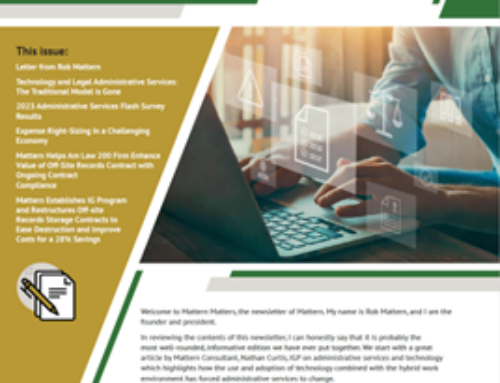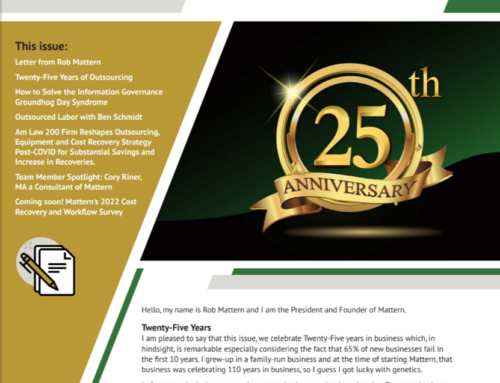Mattern & Associates, LLC Helps Best Best & Krieger Improve Support Services to Save 23% Annually
Best Best & Krieger, LLP is a 180 attorney law firm that has been in business for more than a century. The firm has grown to include several dynamic practice groups across eight offices throughout California.
As with most firms, we have become increasingly mindful of operational expenses and their impact on the firm’s bottom line. Facilities management is one area that has always been a challenge for us to manage efficiently on a firm-wide basis. However, these legal support services, including the copy room, mail and overnight deliveries, faxing, hospitality, inventory and supplies management, as well as administrative and maintenance tasks, are essential elements in the firm’s day-to-day operations.
To manage these processes and allow us to focus on billable work, we had retained the services of three different facilities management vendors to help us evaluate and make decisions about personnel and equipment. However, since the final decisions were made on a per-office rather than centralized basis, the end result was that the firm had three different equipment platforms, three labor staff vendors and multiple contracts with multiple termination dates. This lack of consistency was particularly frustrating for attorneys and staff who traveled from office to office because they had to quickly acclimate to new equipment and processes.
With costs for our legal support services reaching approximately $1.7 million per year, we decided to centralize these decisions according to a strategic and consistent firm-wide policy. Specifically, we were looking to achieve consistency throughout our offices, reduce the number of vendors, negotiate better pricing and improve our contract terms. We also wanted to fully evaluate costs billed by our current vendors. At the same time, we wanted to be sure our bill-back rates for these services were competitive.
After considering a number of consulting firms, we selected Mattern & Associates, LLC, Support Services Advisors to help us streamline our facilities management processes. President and Founder Rob Mattern and his team are well-respected and extremely knowledgeable, with a proven methodology for analyzing, benchmarking, strategy development and decision making.
We started working with Mattern a year ago, taking the time to truly define our needs and get manager “buy-in” from each office. Mattern led us through a Best Practices Operational Review of our outsourced support services operation, which included an assessment of the current situation, handling RFPs through the contract stage, and monitoring and maintaining contracts through their duration.
Mattern began by analyzing all the billing and contracts, and then conducted on-site observations to see how things truly flowed in each of our offices. This evaluation included their administering a survey to determine end user satisfaction levels with current support services and equipment.
Looking at print process, price, and people, Mattern put the responsibility back on the vendor. They talked with all of our offices about their processes, needs, workflow and their likes and dislikes. They also interviewed us to determine our expectations for pricing, equipment and paper services. Mattern presented a comprehensive report of findings and recommendations, noting what was already good, highlighting where improvements could be made, and documenting where the firm stood vis-à-vis comparable firms in the industry.
Based on this report, Mattern created an RFI to narrow down the vendors which would receive the RFP. Five vendors were selected to complete the RFP, each of whom also presented in-person. All the office managers were involved in the decision process. After we narrowed the list down to three finalists, another on-site meeting was held with higher management, including the COO, to choose the winning vendor.
Mattern spearheaded all of this, which enabled us to remain focused on our core business. Mattern’s project manager was often on-site, always available, and very quick to respond. He not only provided a professionalized approach, but also delivered outstanding customer service, going above and beyond to offer a personal touch that really resonated with our staff. We considered the Mattern team to be true partners.
Ultimately, we were able to achieve our goals. We successfully developed a firmwide strategy for support services and simplified our vendor selection and contract negotiation processes. We replaced three vendors with just one, resulting in savings of close to 23% per month in comparison to our previous contracts, without compromising quality or service.
By offering our firm specialized industry knowledge and the benefit of invaluable benchmarking data, Mattern helped us determine the “going rate” for costs. They allowed us to obtain an office services vendor that saved us money and even potentially enhanced the services we had before. With Mattern’s fee structure, we paid a deposit up-front, and then the chosen vendor reimbursed the fee, so hiring Mattern was truly a no-lose proposition for us, from start to finish.
Another key advantage Mattern delivered was in contract structuring and negotiation. They structured our vendor contract with built-in flexibility, allowing us to upgrade or downgrade services and equipment according to need, without us having to modify or extend our contract.
Now, Mattern provides contract monitoring and maintenance to safeguard the terms and help with any addendums that might be needed. In the future, they will also remind us to review the contract and process a year prior to expiration. The Mattern team did all the leg work, dealing with the vendors from the RFI and RFP stage, all the way through to announcing the selection and handling the negotiations. I had full confidence in their ability to manage this process and minimal time was required on my end. Moreover, this was really an enjoyable project. Negotiations are usually difficult, but this was actually pain-free.
Given their in-depth industry knowledge, efficiency-minded approach and committed team, we would certainly retain Mattern & Associates again in the future. In fact, we are now considering hiring them to help us find service providers for additional services such as off-site records storage, office supplies and overnight delivery. They are truly experts in their field and are a pleasure to work with as well. You can’t get much better than that!
Susan Plummer is Director of Finance at Best Best & Krieger, LLP, a full-service law firm with eight offices strategically located to serve California’s most dynamic communities.
Don’t change that printer before you have a plan.
Your firm has local printers, multifunctional devices and high-speed network printers. You also have local and networked color printers, centralized color copiers, and possibly some walk-up color copiers or hybrid black & white/color machines. All these units are probably managed by different teams with varied methods of procurement and service providers. Each device has a different contract with a different pricing structure and minimums.
Flash Forward: you have five emails in your inbox and two voicemails from irate lawyers or secretaries requesting (demanding) their printers be replaced.
With all these variables, how do you know which printer(s) should be replaced? The answer is, in all probability, you don’t know. What your firm therefore needs is an Output Management Plan.
Here’s how to develop one:
1. Centralize output decisions All output decisions should be centralized under a single point of contact/decision making authority. How many times do you see a network printer and multifunction device (MFD) sitting side-byside, managed by two different groups? Or each secretary having their own printer when there is a network printer or MFD sitting around the corner? There should be one entity – let’s call it the output department – within a firm that makes these decisions to avoid redundancy.
2. Know your costs
One of the responsibilities of this output department is to know the firm’s costs. This should include total cost of ownership, cost per impression per device, monthly/annual volumes, and what type of media is printed on the unit. If you may think that seven-year-old printer down the hall costs you nothing as it’s already been paid for, think again.
3. What are the firm’s output goals?
Does the firm want to provide color and black & white output in the most convenient manner possible? Is it the firm’s preference to provide access to color only when required? Is it more important to provide end-users output options that ensure time away from their desk is minimized? Is the firm looking to minimize costs across the board?
4. Explore how to place devices to meet these goals
Once these goals are defined – and you know your costs per impression per unit, and your volume per user/workgroup – you can develop the optimum configuration. Depending upon your floor plan, there may be two network printers for two administrative assistants, shared with a total of eight attorneys and paralegals. Down the hall may be a high-speed color and black & white MFD that is also a high speed scanner. Further away (but on the same floor) may be another high-speed color and black & white MFD that is also a high-speed scanner available for backup. Based on this scenario, your MFD will provide the lowest-priced output, followed by the two network printers (assuming these units are procured correctly). The end-users will have access to low-cost color output as needed. Note, there are no local printers included in this configuration.
5. Create a migration plan Once you have the optimum configuration developed, how do you get there? This will depend on a number of factors, including age of equipment, lease/service obligations and management buy-in. Once users hear you are developing an output plan, they will most likely conclude you will be taking their local printers away (which is actually true) but this is not how you want to start. It’s far easier to take away something in the future if you give something now. We recommend a firm networks MFDs and provides color access (if that is a goal) very early in the process. Once end-users embrace these forms of output and begin to utilize them, then it will be much easier to implement a migration plan that decreases the number of local printers. This is not to say there is no place in a firm for local printers but they should be few and far between and based on sound justifications.



